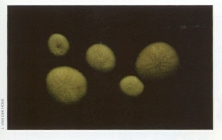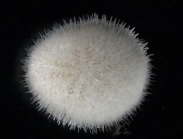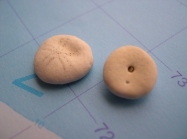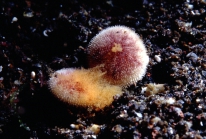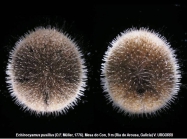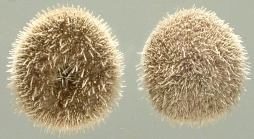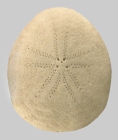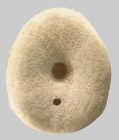
| Introduction | | Search taxa | | Taxon tree | | Taxon match | | Checklist | | Literature | | Stats | | Photogallery | | OBIS Vocab | | Log in |
CaRMS taxon detailsEchinocyamus pusillus (O.F. Müller, 1776)
124273 (urn:lsid:marinespecies.org:taxname:124273)
accepted
Species
marine,
recent + fossil
(of ) Müller, O. F. (1776). Zoologiae Danicae prodromus, seu Animalium Daniae et Norvegiae indigenarum: characteres, nomina, et synonyma imprimis popularium. <em>Typis Hallagerii, Havni, Copenhagen.</em> 282 pp., available online at http://www.biodiversitylibrary.org/item/47550
page(s): 236 [details]
Description Echinocyamus pusillus is a small sea urchin with an oval, flattened body measuring up to 15 mm long. The calcite skeleton...
Description Echinocyamus pusillus is a small sea urchin with an oval, flattened body measuring up to 15 mm long. The calcite skeleton is completely covered with fine short spines and coloured grey to greenish. Specimens become completely green when injured, a characteristic the species shares with some other sea urchin species. [details] Distribution Echinocyamus pusillus occurred outside the near-coastal zone in both periods. In the 1994-2001 period the species was...
Distribution Echinocyamus pusillus occurred outside the near-coastal zone in both periods. In the 1994-2001 period the species was furthermore observed a number of times in the western coastal zone. Maximum density is 400 ind./m2 (1994-2001 period). [details] Distribution Sublittoral to more than 200 m depth, in coarse sand and fine gravel, common all around British Isles
Distribution Sublittoral to more than 200 m depth, in coarse sand and fine gravel, common all around British Isles [details] Distribution It is dominant at the Cleaver Bank and in the south-western part of the Southern Bight. The species is absent from the...
Distribution It is dominant at the Cleaver Bank and in the south-western part of the Southern Bight. The species is absent from the Wadden Sea, the Delta area, the Voordelta, the Dutch coast and the Oyster Ground. [details]
Kroh, A.; Mooi, R. (2021). World Echinoidea Database. Echinocyamus pusillus (O.F. Müller, 1776). Accessed through: Kennedy, M.K., L. Van Guelpen, G. Pohle, L. Bajona (Eds.) (2021) Canadian Register of Marine Species at: https://www.marinespecies.org/Carms/aphia.php?p=taxdetails&id=124273 on 2024-04-23
Nozères, C., Kennedy, M.K. (Eds.) (2024). Canadian Register of Marine Species. Echinocyamus pusillus (O.F. Müller, 1776). Accessed at: https://www.marinespecies.org/carms/aphia.php?p=taxdetails&id=124273 on 2024-04-23
original description
(of ) Müller, O. F. (1776). Zoologiae Danicae prodromus, seu Animalium Daniae et Norvegiae indigenarum: characteres, nomina, et synonyma imprimis popularium. <em>Typis Hallagerii, Havni, Copenhagen.</em> 282 pp., available online at http://www.biodiversitylibrary.org/item/47550
page(s): 236 [details] context source (Deepsea) Intergovernmental Oceanographic Commission (IOC) of UNESCO. The Ocean Biogeographic Information System (OBIS), available online at http://www.iobis.org/ [details] context source (BeRMS 2020) Bio-environmental research group; Institute of Agricultural and Fisheries research (ILVO), Belgium; (2016): Macrobenthos monitoring at long-term monitoring stations in the Belgian part of the North Sea from 2001 on. [details] basis of record Hansson, H.G. (2001). Echinodermata, <B><I>in</I></B>: Costello, M.J. <i>et al.</i> (Ed.) (2001). <i>European register of marine species: a check-list of the marine species in Europe and a bibliography of guides to their identification. Collection Patrimoines Naturels,</i>. 50: pp. 336-351. (look up in IMIS) [details] additional source Mortensen, T. (1948). A Monograph of the Echinoidea. IV, 2. Clypeasteroida. Clypeasteridæ, Arachnoidæ, Fibulariidæ, Laganidæ and Scutellidæ. 471 pp., C. A. Reitzel, Copenhagen. page(s): 178-183 [details] additional source Southward, E.C.; Campbell, A.C. (2006). [Echinoderms: keys and notes for the identification of British species]. <i>Synopses of the British fauna (new series)</i>, 56. Field Studies Council: Shrewsbury, UK. ISBN 1-85153-269-2. 272 pp. (look up in IMIS) [details] additional source Muller, Y. (2004). Faune et flore du littoral du Nord, du Pas-de-Calais et de la Belgique: inventaire. [Coastal fauna and flora of the Nord, Pas-de-Calais and Belgium: inventory]. <em>Commission Régionale de Biologie Région Nord Pas-de-Calais: France.</em> 307 pp., available online at http://www.vliz.be/imisdocs/publications/145561.pdf [details] additional source Hansson, H. (2004). North East Atlantic Taxa (NEAT): Nematoda. Internet pdf Ed. Aug 1998., available online at http://www.tmbl.gu.se/libdb/taxon/taxa.html [details] Available for editors new combination reference Gray, J.E. (1825). An attempt to divide the Echinida, or Sea Eggs, into natural families. <em>Annals of Philosophy, new series.</em> 10:423-431., available online at https://archive.org/stream/annalsofphilosop10lond#page/422/mode/2up page(s): 428 [details]  Present Present  Inaccurate Inaccurate  Introduced: alien Introduced: alien  Containing type locality Containing type locality
From editor or global species database
Biology E. pusillus has separate sexes and fertilization takes place externally. The breeding season is in the summer months. The larvae are pelagic. They are characterized by a body skeleton forming a basket-like structure (Mortensen, 1927; Fish & Fish, 1989).E. pusillus is a deposit-feeding clypeasteroid. lts gut content includes sediment, remains of plants and bottom material (detritus), and infauna, especially foraminiferans. E. pusillus is eaten by fish, especially by dab and haddock (Mortensen, 1927; De Ridder & Lawrence, 1982; Fish & Fish, 1989). [details] Description Echinocyamus pusillus is a small sea urchin with an oval, flattened body measuring up to 15 mm long. The calcite skeleton is completely covered with fine short spines and coloured grey to greenish. Specimens become completely green when injured, a characteristic the species shares with some other sea urchin species. [details] Distribution Echinocyamus pusillus occurred outside the near-coastal zone in both periods. In the 1994-2001 period the species was furthermore observed a number of times in the western coastal zone. Maximum density is 400 ind./m2 (1994-2001 period). [details] Distribution Sublittoral to more than 200 m depth, in coarse sand and fine gravel, common all around British Isles [details] Habitat In the Dutch sector of the North Sea E. pusillus mainly occurs in the areas between 20 to 30 m of depth, in coarse to medium sand bottoms. [details] Morphology E. pusillus has an oval, much flattened test of up to 15 mm in length. The test is covered with fine short spines and is greyish or greenish in colour. On preservation or when hurt it turns green, a character distinctive of all clypeasteroids (Mortensen, 1927; Southward, 1972; Fish & Fish, 1989; Hayward & Ryland, 1990). [details] From other sources
Breeding Echinopluteus larva. Summer - autumn [details]Distribution It is dominant at the Cleaver Bank and in the south-western part of the Southern Bight. The species is absent from the Wadden Sea, the Delta area, the Voordelta, the Dutch coast and the Oyster Ground. [details] Habitat Echinocyamus pusillus has a preference for medium to coarse-grained sand (median grain size: > 200 μm) and reaches an optimum in sediments with a median grain size of 500-550 μm (relative occurrence: 30%). The species furthermore prefers sediments with a low mud content (maximum 10%). [details] Habitat Known from seamounts and knolls [details]
Encyclopedia of Marine Life of Britain and Ireland
Marine Life Information Network - UK To Barcode of Life (11 barcodes) To Biodiversity Heritage Library (281 publications) To Dyntaxa To European Nucleotide Archive (ENA) To GenBank (6 nucleotides; 3 proteins) To Global Biotic Interactions (GloBI) To PESI To USNM Invertebrate Zoology Echinodermata Collection (31 records) To ITIS |
